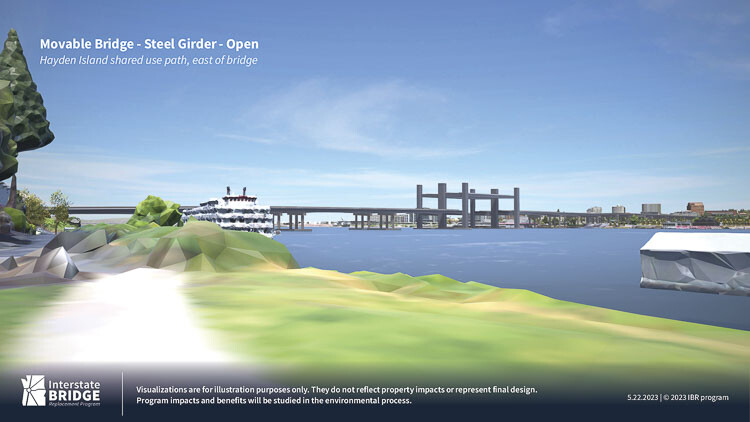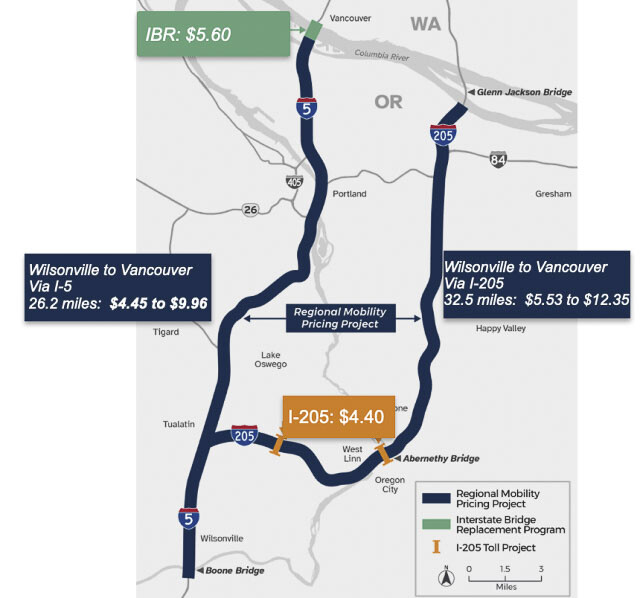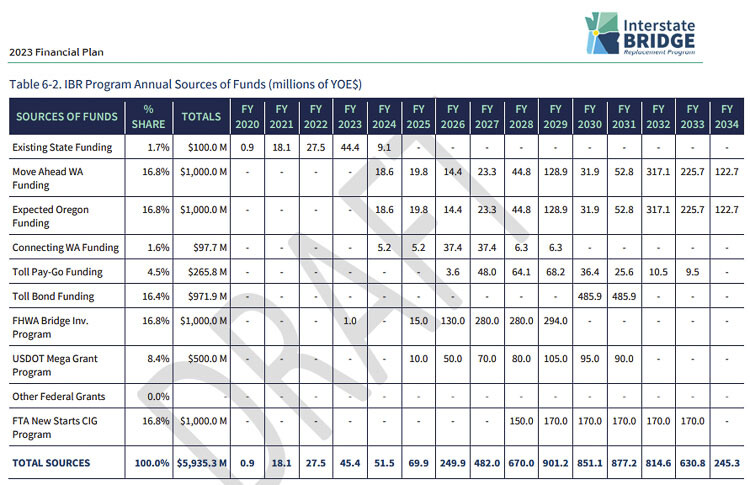Concerns about cost overruns, being tied to light rail and tolling revenues expressed by bi-state legislators
John Ley
for Clark County Today
The 16 Washington and Oregon legislators who make up the Bi-state Bridge Committee met last week for the first time in seven months to get an extensive update. In the past six months, the Washington State Legislature authorized tolling for the Interstate Bridge Replacement (IBR) project. Oregon allocated $250 million from its General Fund revenues, with a promise of $750 million more over the next three biennium.
New to the committee is Rep. Ed Orcutt (Republican, 20th District). He replaces former Rep. Brandon Vick and brings extensive transportation experience, including efforts during the failed Columbia River Crossing (CRC) over a decade ago.
The Interstate Bridge Replacement Program (IBR) Administrator Greg Johnson shared that his team will submit an application to the federal government in August in the hopes of receiving funding from three major federal programs. These programs can provide between 50 and 60 percent of project costs. The IBR is hoping to receive between $1.76 billion and $2.9 billion in federal funding grants.

The program is looking at five different bridge types based upon the three configurations being studied (single-level, double-level, movable span). A technical analysis will compare the trade-offs between the three bridge configurations. They expect a decision regarding bridge configuration will be made in 2024 before the start of the Final SEIS and Amended Record of Decision.
Tolling concerns
Tolling is a major concern to residents on both sides of the Columbia River, but especially Southwest Washington residents who commute to work in Oregon. Johnson shared that his team believes they can expect $1.2 billion to be raised from bonds, paid for by tolling revenues. But Orcutt pushed back, noting the Seattle SR-99 tunnel is only collecting about half their projected revenues. The Washington legislature has had to bail out the state tolling system for the past three years due to declining toll revenues.
Oregon Sen. Lynn Findley expressed concerns about the allocation of tolling dollars. Will all the funds go to service debt? Will some funds be set aside for ongoing operations and maintenance? He noted that the Oregon Department of Transportation (ODOT) has significant funding challenges. The legislature will need to find other revenues to pay for many other transportation projects in the state.
Oregon Rep. Khanh Pham. expressed concerns about the impacts of tolling on low income households. She also noted that the Oregon transportation budget is facing a fiscal cliff, and the state can’t afford to continue using General Fund revenues to pay for the IBR. Pham pleaded for fiscal restraint on the project.
The IBR team is evaluating seven different variable rate tolling scenarios. They begin with rates of $1.50 to $3.55, with a 2.15 percent inflation adjustment as the program moves forward. Some scenarios consider other proposed regional toll projects, which have been reported to include per mile charges up to $30 a day for round trip Vancouver to Wilsonville travel. The Washington State Transportation Commission was briefed earlier this month that bridge tolling would extend until at least 2060.
Others expressed concerns about traffic diversion to avoid the tolls. .Sen. Chris Gorsek of Gresham expressed concerns that the tolling would cause significant traffic diversion onto the I-205 Glenn Jackson Bridge, which is already congested much of the day. IBR’s Ray Maybe acknowledged the bridge is at or above capacity, and then said “we don’t see much diversion.”
That remark triggered pushback during public comment. Portland economist Joe Cortright told the committee that the traffic diversion will probably produce gridlock on I-205. He also said it was foolhardy to move forward at this time without a level 3 investment grade tolling analysis. Cortright noted that in the failed CRC, toll rates had to be doubled to produce the needed revenues following the investment grade analysis.

Light Rail concerns
Sen. Lynda Wilson (Republican 17th District) asked about who would be paying for the operations and maintenance (O&M) of the TriMet MAX light rail. She noted that C-TRAN has said they will not pay for the O&M of the 3-mile light rail extension. Last year, TriMet demanded “new revenues” from both states in order to cover O&M costs. Those costs have not been revealed.
The “high capacity” transit portion of the project is expected to cost between $1.3 billion and $2 billion. Federal grants will only cover up to half the cost, and require at least 15 percent coming from “local funds”. That would mean up to $300 million from the two states for the MAX light rail extension into Vancouver. The potential $666 million per mile cost would far exceed previous TriMet light rail expansions.
The IBR finance plan released earlier this spring indicates the local cost could go higher. “The $300 million of transit eligible state funding assumes that the program receives a $500 million USDOT Mega grant and a $1 billion FTA CIG award; a lesser amount from either of these grant programs would require a larger share of transit eligible state funding.”
Rep. Jake Fey (Democrat, 27th District) sought clarification on transit grants from the federal government. Since the program is seeking funding with light rail as the transit choice, he asked “are we obligated to build light rail?” He is worried that decision makers will be “boxed into a decision that is not the will of this group.”
The IBR’s Frank Green responded saying the federal Mega Grant program is the most flexible. The program believes “light rail will make us most competitive for those funds.”
Design options
The legislators were given their first official look at the multiple virtual design options under consideration revealed last May..Those built with steel are lighter and therefore have a smaller footprint for their in-water foundations. Only one has pedestrians and bicyclists on a lower deck, away from the high speed traffic and noise.
There was considerable discussion about the movable lift span option revealed in May. It is the only option that meets the Coast Guard’s requirement for 178 feet of clearance for marine traffic.
A Feb. 2023 letter from Admiral M.W.Bouboulis stated the following. “I recommend that the Notice to Supplement clearly state the alternatives to be evaluated in the SEIS to include the no build alternative, the locally preferred alternative (116-foot vertical clearance), and an alternative that meets the 178-foot vertical clearance established in the (preliminary navigation clearance determination) PNCD. This will ensure that an alternative that meets the initially identified needs of navigation is evaluated in the SEIS and could be adopted by the Coast Guard.”
In the previous CRC effort, they planned to pay $86.4 million to three up river firms as “mitigation” for the proposed 116-foot bridge design’s negative impacts on their businesses. Pham asked what the current cost estimate is to “buy off” the up river firms. The IBR’s Ray Maybe answered, saying “the costs are much less than a movable span.” The current cost estimate for a movable lift span would be in the $400 to $500 million range.

There was discussion about two park and ride stations in Vancouver. Wilson noted C-TRAN does not believe they are needed. The IBR is studying a “range of options” from zero to two park and ride locations.
During public comment, Puget Sound resident Bob Ortblad pushed for an Immersed Tube Tunnel (ITT). He noted an ITT could save valuable real estate on both Vancouver and Hayden Island.
Portland’s Be Friend asked for an independent study of an ITT. She believes an ITT would only require two interchanges instead of the seven interchange modifications in the IBR plan. Friend also recommended saving the newer Interstate Bridge (1958) and using it as the local connection between Vancouver and Hayden Island.
The ITT would meet the Coast Guard requirement for at least 178 feet of clearance for marine traffic. Friend believes the ITT would save money and cause less negative impacts on local businesses and property owners.
Sarah Iannarone of The Street Trust expressed strong concerns about tolling’s impact on low income and vulnerable system users. Her organization has done extensive outreach on tolling, including the I-205 project. “Many people who’ve used this bridge cannot imagine how they would use it without driving,” she said as she called for more education of people.
Chris Smith of No More Freeways called for an investment grade tolling analysis so the IBR doesn’t overbuild the project with “unnecessary infrastructure.” He pushed back on the program wanting to put the MAX train rails on ties instead of embedding them in concrete so that buses could use the lane.
The IBR expects to complete their Supplemental Environmental Impact Statement by the end of the year. The level 3 investment grade tolling analysis would run about two years from the fall of 2024 until mid to late 2026. Construction would begin in 2026.
Also read:
- Expect delays on northbound I-5 near Ridgefield through May 9Northbound I-5 travelers near Ridgefield should expect delays through May 9 as crews work on improvements at the Exit 14 off-ramp to support future development.
- 6-cent gas tax hike central to new transportation deal in WA LegislatureA proposed 6-cent gas tax hike is central to a transportation funding deal under negotiation in the Washington Legislature, aimed at raising $3.2 billion over six years.
- Letter: C-TRAN Board improper meeting conductCamas resident Rick Vermeers criticizes the C-TRAN Board for misusing parliamentary procedure during a controversial vote on light rail.
- Opinion: TriMet’s ‘fiscal cliff’ a caution for Clark County taxpayersRep. John Ley warns that Portland’s financially troubled TriMet transit system could pose major risks to Clark County taxpayers as the I-5 Bridge replacement moves forward.
- Travel Advisory: Expect daytime delays on northbound I-5 near Woodland for guardrail repairs, April 18WSDOT will close the left lane of northbound I-5 near Woodland on Friday, April 18, to repair guardrail and improve driver safety.









